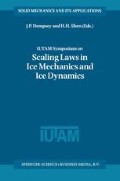Abstract
In cold regions, given that first year-year ice ridges often govern the design load for offshore structure, it is important to obtain knowledge about ice ridges, especially the consolidated portion, in designing offshore structures. However, the physical properties and strength of sea ice ridge appear to be much more complex than those of undeformed ice or level ice. We performed a preliminary series of tests (uniaxial compression tests) in the laboratory on model ice (refrozen rubble) to investigate the strength and the physical properties of the consolidated portion. In order to construct an ice ridge model, cubical ice blocks of size (a) were randomly arranged in the ice tank filled with saline water that had greater salinity than that of the ice blocks. After they were refrozen, using a core drill with various diameters (d), we collected test core samples with a range of d/a ratios. We then examined their physical properties and mechanical characteristics with regard to size effects. In our test results, the difference in ice strength according to the sample’s original location and orientation was small in an ice ridge model compared with level ice, suggesting that the ice ridge strength may be macroscopically isotropic. As with level ice, the strength of the ice ridge decreased with increase in specimen size, indicating a size effect. We discuss this size effect of ice strength on the basis of weakest link theory. Each of the expectation and the standard deviation of the strength is proportional to volume to the -1/β power, where β is regarded as a shape parameter. Both the calculated value estimated from the theory and the experimental value on the ice strength show that the strength of level ice slightly exceeds that of ice ridge model for small specimens, but that the values approach each other as the size of the specimen increases. Also, the strength of level ice and ridge ice appear to have the same asymptotic strength and they may be essentially of the same order. Finally, we proposed a practical application of ridge strength.
Access this chapter
Tax calculation will be finalised at checkout
Purchases are for personal use only
Preview
Unable to display preview. Download preview PDF.
References
Ashton, GD., 1986. River and Lake Ice Engineering. Water Resources Publications, 19–20, 50–79.
Leppäranta, M. and Hakala, R., 1989. Field measurements of the structure and strength of first-year ice ridges in the Baltic sea. Proc. 8 th International Conference on Offshore Mechanics and Arctic Engineering 4, 169–174.
Prodanovic, A., 1979. Model test of ice rubble strength. Proc. Port and Ocean Engineering Under Arctic Conditions 1, 89–105.
Rogachko, S.I., Evdokimov, G.N., Melnikov, M.V., Kärnä, T. and Lehmus, E., 1997. The influence of porosity on mechanical strength of hummocks. Proc. 1e International Conference on Offshore Mechanics and Arctic Engineering 4, 151–157.
Rogachko, S.I. and Kärnä, T., 1999. Experiments on the strength of refrozen layers of first-year ice ridges. Proc. 15 th Port and Ocean Engineering Under Arctic Conditions 3, 1066–1075.
Masaki, M., Honda, H., Takahiro, T., Kawamura, M., Matsusita, M., Sakai, M. and Saeki, H., 1997. Study on characteristics of the strength variation of sea ice and ice force loading on the structure. Proc., Civil Engineering in the Ocean, 13, 843–846.
Tasaki, M., Honda, H., Takahiro, T., Kawamura, M., Matsusita, M., Sakai, M. and Saeki, H., 1997. Study on characteristics of the strength variation of sea ice and ice force loading on the structure. Proc. Civil Engineering in the Ocean 13, 843–846.
Wong, T.T., Gale, A.D. and Sego, D.C., 1986. Shear box tests on broken ice. Proc. Port and Ocean Engineering Under Arctic Conditions 3, 97–107.
Author information
Authors and Affiliations
Editor information
Editors and Affiliations
Rights and permissions
Copyright information
© 2001 Springer Science+Business Media Dordrecht
About this paper
Cite this paper
Kioka, S., Takeuchi, T., Yasunaga, Y., Saeki, H. (2001). The Physical Properties of Consolidated Ridge Ice Modeled as Frozen Rubble. In: Dempsey, J.P., Shen, H.H. (eds) IUTAM Symposium on Scaling Laws in Ice Mechanics and Ice Dynamics. Solid Mechanics and Its Applications, vol 94. Springer, Dordrecht. https://doi.org/10.1007/978-94-015-9735-7_7
Download citation
DOI: https://doi.org/10.1007/978-94-015-9735-7_7
Publisher Name: Springer, Dordrecht
Print ISBN: 978-90-481-5890-4
Online ISBN: 978-94-015-9735-7
eBook Packages: Springer Book Archive

